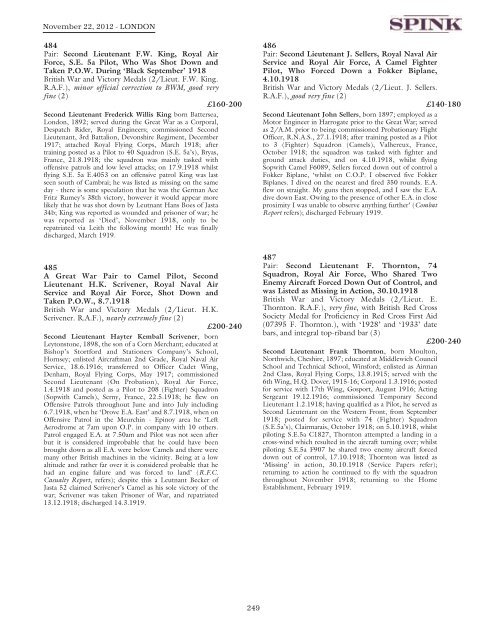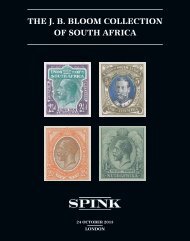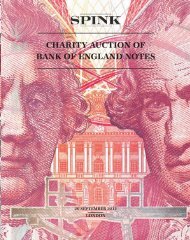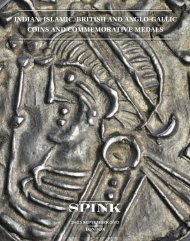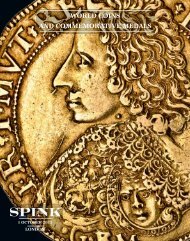orders, decorations, campaign medals and militaria - Spink
orders, decorations, campaign medals and militaria - Spink
orders, decorations, campaign medals and militaria - Spink
You also want an ePaper? Increase the reach of your titles
YUMPU automatically turns print PDFs into web optimized ePapers that Google loves.
November 22, 2012 - LoNdoN<br />
484<br />
Pair: Second Lieutenant F.W. King, Royal Air<br />
Force, S.E. 5a Pilot, Who Was Shot Down <strong>and</strong><br />
Taken P.O.W. During ‘Black September’ 1918<br />
British War <strong>and</strong> Victory Medals (2/Lieut. F.W. King.<br />
R.A.F.), minor official correction to BWM, good very<br />
fine (2)<br />
£160-200<br />
Second Lieutenant Frederick Willis King born Battersea,<br />
London, 1892; served during the Great War as a Corporal,<br />
Despatch Rider, Royal Engineers; commissioned Second<br />
Lieutenant, 3rd Battalion, Devonshire Regiment, December<br />
1917; attached Royal Flying Corps, March 1918; after<br />
training posted as a Pilot to 40 Squadron (S.E. 5a’s), Bryas,<br />
France, 21.8.1918; the squadron was mainly tasked with<br />
offensive patrols <strong>and</strong> low level attacks; on 17.9.1918 whilst<br />
flying S.E. 5a E.4053 on an offensive patrol King was last<br />
seen south of Cambrai; he was listed as missing on the same<br />
day - there is some speculation that he was the German Ace<br />
Fritz Rumey’s 38th victory, however it would appear more<br />
likely that he was shot down by Leutnant Hans Boes of Jasta<br />
34b; King was reported as wounded <strong>and</strong> prisoner of war; he<br />
was reported as ‘Died’, November 1918, only to be<br />
repatriated via Leith the following month! He was finally<br />
discharged, March 1919.<br />
485<br />
A Great War Pair to Camel Pilot, Second<br />
Lieutenant H.K. Scrivener, Royal Naval Air<br />
Service <strong>and</strong> Royal Air Force, Shot Down <strong>and</strong><br />
Taken P.O.W., 8.7.1918<br />
British War <strong>and</strong> Victory Medals (2/Lieut. H.K.<br />
Scrivener. R.A.F.), nearly extremely fine (2)<br />
£200-240<br />
Second Lieutenant Hayter Kemball Scrivener, born<br />
Leytonstone, 1898, the son of a Corn Merchant; educated at<br />
Bishop’s Stortford <strong>and</strong> Stationers Company’s School,<br />
Hornsey; enlisted Aircraftman 2nd Grade, Royal Naval Air<br />
Service, 18.6.1916; transferred to Officer Cadet Wing,<br />
Denham, Royal Flying Corps, May 1917; commissioned<br />
Second Lieutenant (On Probation), Royal Air Force,<br />
1.4.1918 <strong>and</strong> posted as a Pilot to 208 (Fighter) Squadron<br />
(Sopwith Camels), Serny, France, 22.5.1918; he flew on<br />
Offensive Patrols throughout June <strong>and</strong> into July including<br />
6.7.1918, when he ‘Drove E.A. East’ <strong>and</strong> 8.7.1918, when on<br />
Offensive Patrol in the Meurchin - Epinoy area he ‘Left<br />
Aerodrome at 7am upon O.P. in company with 10 others.<br />
Patrol engaged E.A. at 7.50am <strong>and</strong> Pilot was not seen after<br />
but it is considered improbable that he could have been<br />
brought down as all E.A. were below Camels <strong>and</strong> there were<br />
many other British machines in the vicinity. Being at a low<br />
altitude <strong>and</strong> rather far over it is considered probable that he<br />
had an engine failure <strong>and</strong> was forced to l<strong>and</strong>’ (R.F.C.<br />
Casualty Report, refers); despite this a Leutnant Becker of<br />
Jasta 52 claimed Scrivener’s Camel as his sole victory of the<br />
war; Scrivener was taken Prisoner of War, <strong>and</strong> repatriated<br />
13.12.1918; discharged 14.3.1919.<br />
249<br />
486<br />
Pair: Second Lieutenant J. Sellers, Royal Naval Air<br />
Service <strong>and</strong> Royal Air Force, A Camel Fighter<br />
Pilot, Who Forced Down a Fokker Biplane,<br />
4.10.1918<br />
British War <strong>and</strong> Victory Medals (2/Lieut. J. Sellers.<br />
R.A.F.), good very fine (2)<br />
£140-180<br />
Second Lieutenant John Sellers, born 1897; employed as a<br />
Motor Engineer in Harrogate prior to the Great War; served<br />
as 2/A.M. prior to being commissioned Probationary Flight<br />
Officer, R.N.A.S., 27.1.1918; after training posted as a Pilot<br />
to 3 (Fighter) Squadron (Camels), Valhereux, France,<br />
October 1918; the squadron was tasked with fighter <strong>and</strong><br />
ground attack duties, <strong>and</strong> on 4.10.1918, whilst flying<br />
Sopwith Camel F6089, Sellers forced down out of control a<br />
Fokker Biplane, ‘whilst on C.O.P. I observed five Fokker<br />
Biplanes. I dived on the nearest <strong>and</strong> fired 350 rounds. E.A.<br />
flew on straight. My guns then stopped, <strong>and</strong> I saw the E.A.<br />
dive down East. Owing to the presence of other E.A. in close<br />
proximity I was unable to observe anything further’ (Combat<br />
Report refers); discharged February 1919.<br />
487<br />
Pair: Second Lieutenant F. Thornton, 74<br />
Squadron, Royal Air Force, Who Shared Two<br />
Enemy Aircraft Forced Down Out of Control, <strong>and</strong><br />
was Listed as Missing in Action, 30.10.1918<br />
British War <strong>and</strong> Victory Medals (2/Lieut. E.<br />
Thornton. R.A.F.), very fine, with British Red Cross<br />
Society Medal for Proficiency in Red Cross First Aid<br />
(07395 F. Thornton.), with ‘1928’ <strong>and</strong> ‘1933’ date<br />
bars, <strong>and</strong> integral top-rib<strong>and</strong> bar (3)<br />
£200-240<br />
Second Lieutenant Frank Thornton, born Moulton,<br />
Northwich, Cheshire, 1897; educated at Middlewich Council<br />
School <strong>and</strong> Technical School, Winsford; enlisted as Airman<br />
2nd Class, Royal Flying Corps, 13.8.1915; served with the<br />
6th Wing, H.Q. Dover, 1915-16; Corporal 1.3.1916; posted<br />
for service with 17th Wing, Gosport, August 1916; Acting<br />
Sergeant 19.12.1916; commissioned Temporary Second<br />
Lieutenant 1.2.1918; having qualified as a Pilot, he served as<br />
Second Lieutenant on the Western Front, from September<br />
1918; posted for service with 74 (Fighter) Squadron<br />
(S.E.5a’s), Clairmarais, October 1918; on 5.10.1918, whilst<br />
piloting S.E.5a C1827, Thornton attempted a l<strong>and</strong>ing in a<br />
cross-wind which resulted in the aircraft turning over; whilst<br />
piloting S.E.5a F907 he shared two enemy aircraft forced<br />
down out of control, 17.10.1918; Thornton was listed as<br />
‘Missing’ in action, 30.10.1918 (Service Papers refer);<br />
returning to action he continued to fly with the squadron<br />
throughout November 1918; returning to the Home<br />
Establishment, February 1919.


